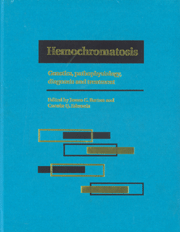Book contents
- Frontmatter
- Contents
- List of contributors
- Foreword
- Part I Introduction to hemochromatosis
- Part II Genetics of hemochromatosis
- Part III Metal absorption and metabolism in hemochromatosis
- 10 Intestinal iron-binding proteins
- 11 Intestinal iron absorption and hemochromatosis
- 12 The absorption and metabolism of non-ferrous metals in hemochromatosis
- 13 Ferritin metabolism in hemochromatosis
- 14 Hepatic iron metabolism in hemochromatosis
- 15 Extra-hepatic iron metabolism in hemochromatosis
- 16 Mathematical models of metal metabolism in hemochromatosis
- 17 Expression of iron overload in hemochromatosis
- Part IV Diagnostic techniques for iron overload
- Part V Complications of iron overload
- Part VI Therapy of hemochromatosis and iron overload
- Part VII Infections and immunity in hemochromatosis
- Part VIII Hemochromatosis heterozygotes
- Part IX Relationship of hemochromatosis to other disorders
- Part X Animal models of hemochromatosis and iron overload
- Part XI Screening for hemochromatosis
- Part XII Hemochromatosis: societal and ethical issues
- Part XIII Final issues
- Index
13 - Ferritin metabolism in hemochromatosis
from Part III - Metal absorption and metabolism in hemochromatosis
Published online by Cambridge University Press: 05 August 2011
- Frontmatter
- Contents
- List of contributors
- Foreword
- Part I Introduction to hemochromatosis
- Part II Genetics of hemochromatosis
- Part III Metal absorption and metabolism in hemochromatosis
- 10 Intestinal iron-binding proteins
- 11 Intestinal iron absorption and hemochromatosis
- 12 The absorption and metabolism of non-ferrous metals in hemochromatosis
- 13 Ferritin metabolism in hemochromatosis
- 14 Hepatic iron metabolism in hemochromatosis
- 15 Extra-hepatic iron metabolism in hemochromatosis
- 16 Mathematical models of metal metabolism in hemochromatosis
- 17 Expression of iron overload in hemochromatosis
- Part IV Diagnostic techniques for iron overload
- Part V Complications of iron overload
- Part VI Therapy of hemochromatosis and iron overload
- Part VII Infections and immunity in hemochromatosis
- Part VIII Hemochromatosis heterozygotes
- Part IX Relationship of hemochromatosis to other disorders
- Part X Animal models of hemochromatosis and iron overload
- Part XI Screening for hemochromatosis
- Part XII Hemochromatosis: societal and ethical issues
- Part XIII Final issues
- Index
Summary
Introduction
In all mammalian cells, iron in excess of current metabolic requirements is incorporated into ferritin. Effective iron storage is an essential component of cellular iron homeostasis, because iron not sequestered within the cell can catalyze potentially cytotoxic free radical-generating reactions. Although all cells can store iron in ferritin, macrophages and hepatocytes are particularly adapted for this function and retain excess iron as a reserve for times of increased body iron needs. The hepatocyte can take up iron in a variety of different forms and act as a major site of available iron stores, and thus has a central ‘buffering’ role in internal iron exchange.
Because hemochromatosis is an iron storage disorder, ferritin, the principal iron storage protein, plays an important role in the disease. Ferritin sequesters the iron distributed throughout the body as a consequence of elevated intestinal iron absorption. The serum ferritin concentration accurately reflects the body iron load and provides a valuable diagnostic tool. The iron in ferritin is not biologically inert but can be utilized readily for various cellular functions. The ability of ferritin to release iron in times of demand is essential physiologically but also underlies the treatment of hemochromatosis by phlebotomy therapy.
Aspects of ferritin metabolism relevant to hemochromatosis will be discussed in this chapter. The areas covered include a brief overview of ferritin biochemistry, a discussion of ferritin synthesis and its regulation in the intestinal mucosa, the liver and the reticuloendothelial (RE) system, and the role played by the serum ferritin concentration in the diagnosis of hemochromatosis.
- Type
- Chapter
- Information
- HemochromatosisGenetics, Pathophysiology, Diagnosis and Treatment, pp. 145 - 156Publisher: Cambridge University PressPrint publication year: 2000



